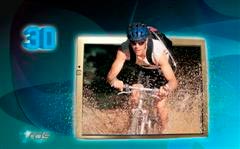
Posted to News on 26th Nov 2012, 17:44
RDS introduces 3D LCD displays that do not need special glasses
Review Display Systems Ltd (RDS) is announcing a new range of 3D LCD Display Panels with 7.2, 10 and 12-inch diagonals. Developed by NLT Technologies, the 3D LCD Display Module is said use a different technology from that applied in most television applications, and no special glasses are necessary to see a 3D image.

Referred to as Horizontally Double-Density Pixel (HDDP) technology with lenticular lens, the technology enables 2D and 3D images to be displayed simultaneously on the same screen at the same resolution by changing the image-data input. Additionally, 2D and 3D images have the same brightness and same resolution. With this technology, the 3D display modules achieve high-quality 3D viewing without the use of special glasses. Conventional LCD modules comprise square pixels with RGB sub-pixels distributed in vertical stripes. In a conventional LCD module layout, two pixels are required to display a 3D image, thus cutting the horizontal resolution in half. Using the HDDP structure, however, RGB sub-pixels are rotated 90 degrees and divided to achieve double-density resolution. This makes it possible to use the same display resolution for both 2D and 3D images.
Multi-view auto-stereoscopic 3D images require greater resolution than 2D images. NLT's HDDP 3D LCD modules provide double the horizontal pixel density of conventional LCDs, so each eye receives a full-resolution image - hence 3D performance is excellent. Graham Smith, the Sales Manager at Review Display Systems, says: "With the ability to display more realistic 3D images or data to the user, without the use of special glasses, it is much more than just a 'flat panel' - it is a truly realistic 3D image display."
Generally, an auto-stereoscopic display creates 'eye viewing space' (EVS) for each eye, with high luminance contrast. Typically a lenticular lens is implemented to create an EVS. The human eye sees 3D images in the qualified stereoscopic viewing space (QSVS) - the viewing space with high 3D contrast where each eye sees a unique image, a space also known as the 'sweet spot'. The amount of right eye's data seen by the left eye or vice versa is known as crosstalk. Generally speaking, if 3D crosstalk is lower than 10 per cent, the human eye perceives a 3D image. The lower the crosstalk the more natural and realistic 3D images appear.
The NL8060BH18-xx series displays show the perception of depth of image or displaying a 3D camera. They are suitable for use as monitors for broadcast, movie browsers or 3D cameras. Typically, models within the NL8060BH18-xx range include an, LVDS interface with RGB 8 bits each, a resolution of 800 x 600 (1600 x 600 with double the horizontal pixel density), 600:1 contrast ratio screen with 262k colours. Luminance is around 380cd/cm2, power supply voltage is 3.3V and operating temperature is 0 to +55degC. Overall dimensions for the 7.2-inch models are 164.3 x 125.4 x 6.5mm.
Find out more about the 3D LCD Panels on the RDS website at www.review-displays.co.uk.
Want the latest machine building news straight to your inbox? Become a MachineBuilding member for free today >>

















